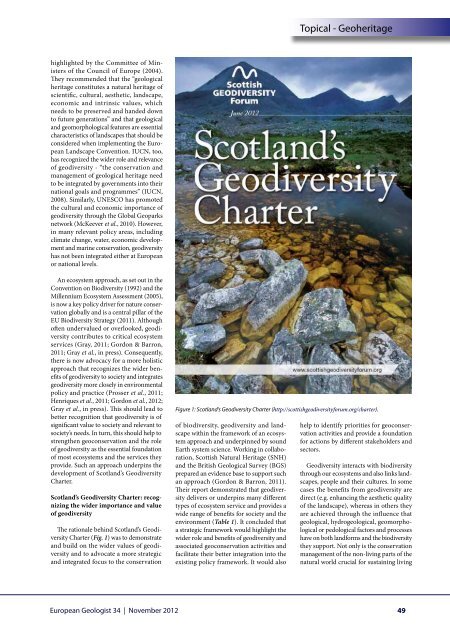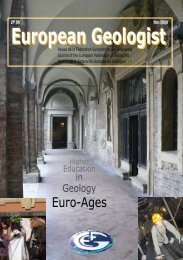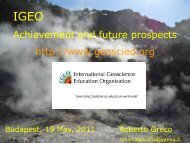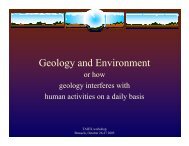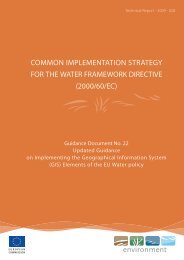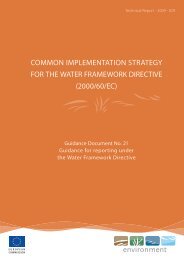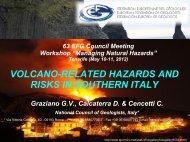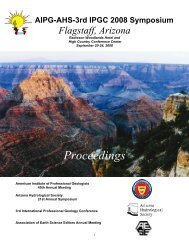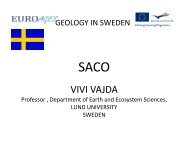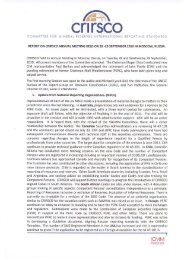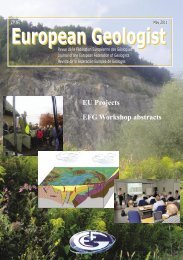European Geologist European Geologist Geoheritage - learning ...
European Geologist European Geologist Geoheritage - learning ...
European Geologist European Geologist Geoheritage - learning ...
You also want an ePaper? Increase the reach of your titles
YUMPU automatically turns print PDFs into web optimized ePapers that Google loves.
Topical - <strong>Geoheritage</strong><br />
highlighted by the Committee of Ministers<br />
of the Council of Europe (2004).<br />
They recommended that the “geological<br />
heritage constitutes a natural heritage of<br />
scientific, cultural, aesthetic, landscape,<br />
economic and intrinsic values, which<br />
needs to be preserved and handed down<br />
to future generations” and that geological<br />
and geomorphological features are essential<br />
characteristics of landscapes that should be<br />
considered when implementing the <strong>European</strong><br />
Landscape Convention. IUCN, too,<br />
has recognized the wider role and relevance<br />
of geodiversity - “the conservation and<br />
management of geological heritage need<br />
to be integrated by governments into their<br />
national goals and programmes” (IUCN,<br />
2008). Similarly, UNESCO has promoted<br />
the cultural and economic importance of<br />
geodiversity through the Global Geoparks<br />
network (McKeever et al., 2010). However,<br />
in many relevant policy areas, including<br />
climate change, water, economic development<br />
and marine conservation, geodiversity<br />
has not been integrated either at <strong>European</strong><br />
or national levels.<br />
An ecosystem approach, as set out in the<br />
Convention on Biodiversity (1992) and the<br />
Millennium Ecosystem Assessment (2005),<br />
is now a key policy driver for nature conservation<br />
globally and is a central pillar of the<br />
EU Biodiversity Strategy (2011). Although<br />
often undervalued or overlooked, geodiversity<br />
contributes to critical ecosystem<br />
services (Gray, 2011; Gordon & Barron,<br />
2011; Gray et al., in press). Consequently,<br />
there is now advocacy for a more holistic<br />
approach that recognizes the wider benefits<br />
of geodiversity to society and integrates<br />
geodiversity more closely in environmental<br />
policy and practice (Prosser et al., 2011;<br />
Henriques et al., 2011; Gordon et al., 2012;<br />
Gray et al., in press). This should lead to<br />
better recognition that geodiversity is of<br />
significant value to society and relevant to<br />
society’s needs. In turn, this should help to<br />
strengthen geoconservation and the role<br />
of geodiversity as the essential foundation<br />
of most ecosystems and the services they<br />
provide. Such an approach underpins the<br />
development of Scotland’s Geodiversity<br />
Charter.<br />
Scotland’s Geodiversity Charter: recognizing<br />
the wider importance and value<br />
of geodiversity<br />
The rationale behind Scotland’s Geodiversity<br />
Charter (Fig. 1) was to demonstrate<br />
and build on the wider values of geodiversity<br />
and to advocate a more strategic<br />
and integrated focus to the conservation<br />
Figure 1: Scotland’s Geodiversity Charter (http://scottishgeodiversityforum.org/charter).<br />
of biodiversity, geodiversity and landscape<br />
within the framework of an ecosystem<br />
approach and underpinned by sound<br />
Earth system science. Working in collaboration,<br />
Scottish Natural Heritage (SNH)<br />
and the British Geological Survey (BGS)<br />
prepared an evidence base to support such<br />
an approach (Gordon & Barron, 2011).<br />
Their report demonstrated that geodiversity<br />
delivers or underpins many different<br />
types of ecosystem service and provides a<br />
wide range of benefits for society and the<br />
environment (Table 1). It concluded that<br />
a strategic framework would highlight the<br />
wider role and benefits of geodiversity and<br />
associated geoconservation activities and<br />
facilitate their better integration into the<br />
existing policy framework. It would also<br />
help to identify priorities for geoconservation<br />
activities and provide a foundation<br />
for actions by different stakeholders and<br />
sectors.<br />
Geodiversity interacts with biodiversity<br />
through our ecosystems and also links landscapes,<br />
people and their cultures. In some<br />
cases the benefits from geodiversity are<br />
direct (e.g. enhancing the aesthetic quality<br />
of the landscape), whereas in others they<br />
are achieved through the influence that<br />
geological, hydrogeological, geomorphological<br />
or pedological factors and processes<br />
have on both landforms and the biodiversity<br />
they support. Not only is the conservation<br />
management of the non-living parts of the<br />
natural world crucial for sustaining living<br />
<strong>European</strong> <strong>Geologist</strong> 34 | November 2012<br />
49


